tow TOYOTA SEQUOIA 2020 Owners Manual (in English)
[x] Cancel search | Manufacturer: TOYOTA, Model Year: 2020, Model line: SEQUOIA, Model: TOYOTA SEQUOIA 2020Pages: 588, PDF Size: 12.33 MB
Page 3 of 588
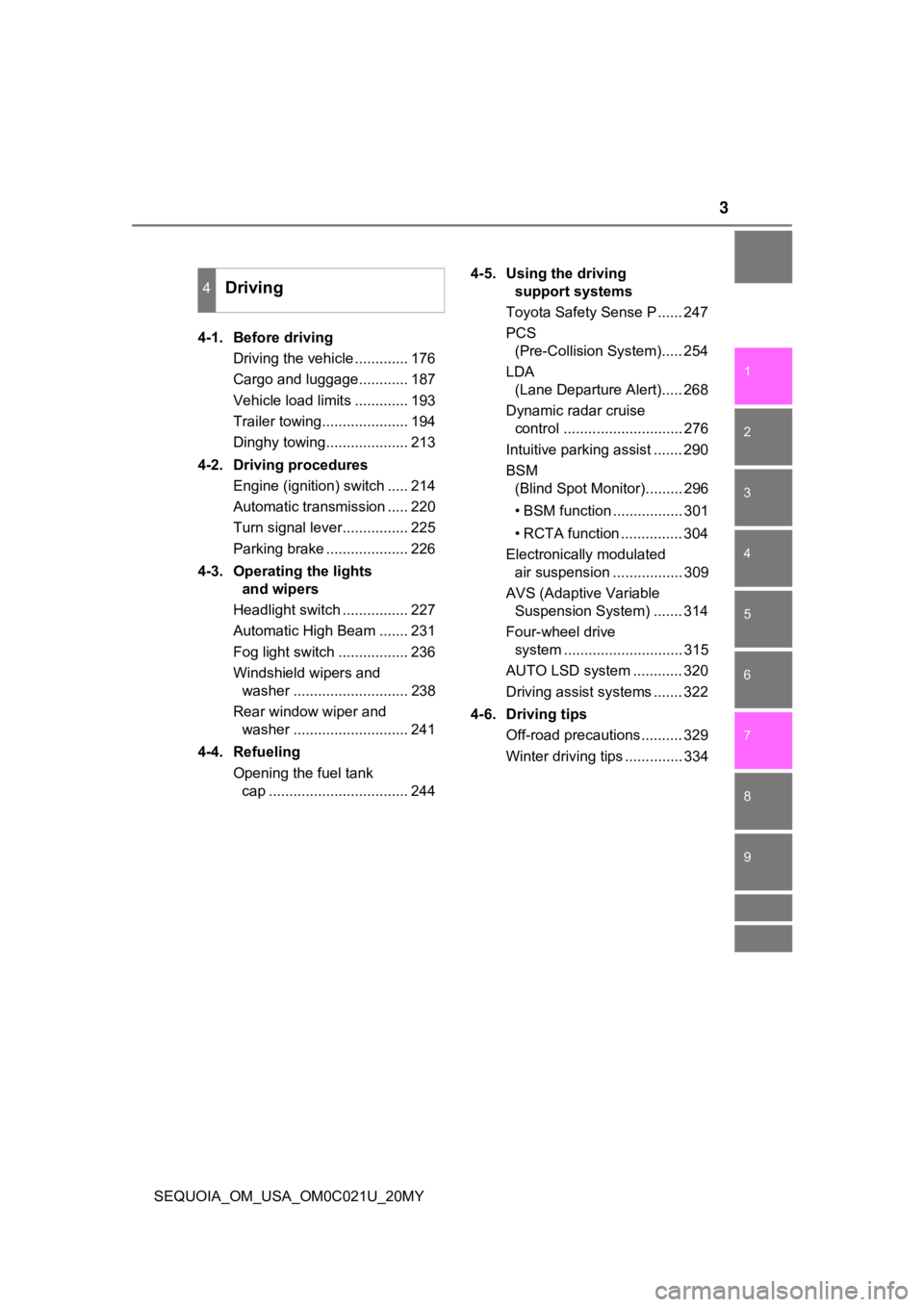
3
1
8 7
6
5
4
3
2
9
SEQUOIA_OM_USA_OM0C021U_20MY4-1. Before driving
Driving the vehicle ............. 176
Cargo and luggage............ 187
Vehicle load limits ............. 193
Trailer towing..................... 194
Dinghy towing.................... 213
4-2. Driving procedures Engine (ignition) switch ..... 214
Automatic transmission ..... 220
Turn signal lever................ 225
Parking brake .................... 226
4-3. Operating the lights and wipers
Headlight switch ................ 227
Automatic High Beam ....... 231
Fog light switch ................. 236
Windshield wipers and washer ............................ 238
Rear window wiper and washer ............................ 241
4-4. Refueling Opening the fuel tank cap .................................. 244 4-5. Using the driving
support systems
Toyota Safety Sense P ...... 247
PCS (Pre-Collision System)..... 254
LDA (Lane Departure Alert)..... 268
Dynamic radar cruise control ............................. 276
Intuitive parking assist ....... 290
BSM (Blind Spot Monitor)......... 296
• BSM function ................. 301
• RCTA function ............... 304
Electronically modulated air suspension ................. 309
AVS (Adaptive Variable Suspension System) ....... 314
Four-wheel drive system ............................. 315
AUTO LSD system ............ 320
Driving assist systems ....... 322
4-6. Driving tips Off-road precautions .......... 329
Winter driving tips .............. 334
4Driving
Page 5 of 588
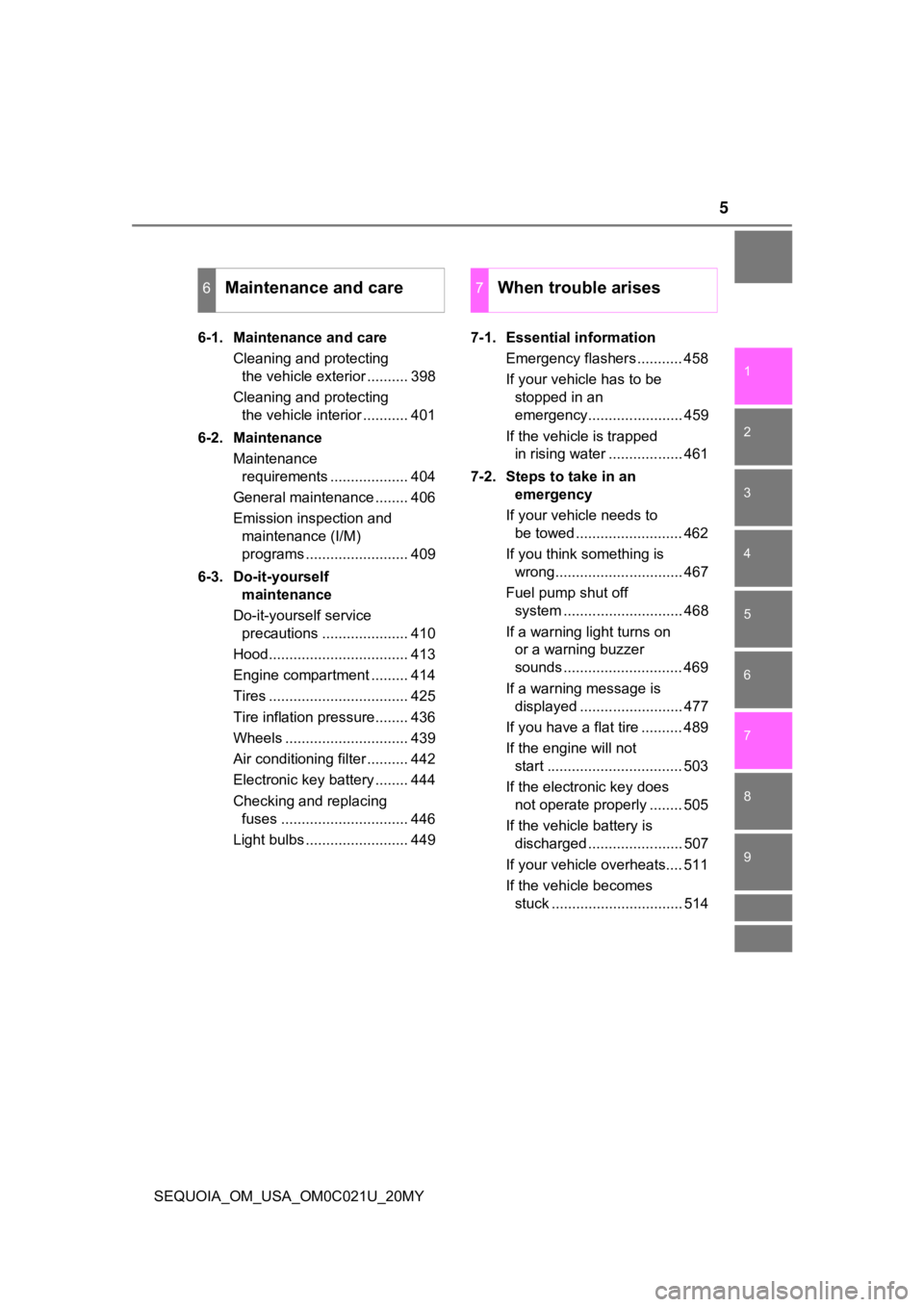
5
1
8 7
6
5
4
3
2
9
SEQUOIA_OM_USA_OM0C021U_20MY6-1. Maintenance and care
Cleaning and protecting the vehicle exterior .......... 398
Cleaning and protecting the vehicle interior ........... 401
6-2. Maintenance Maintenance requirements ................... 404
General maintenance ........ 406
Emission inspection and maintenance (I/M)
programs ......................... 409
6-3. Do-it-yourself maintenance
Do-it-yourself service precautions ..................... 410
Hood.................................. 413
Engine compartment ......... 414
Tires .................................. 425
Tire inflation pressure........ 436
Wheels .............................. 439
Air conditioning filter .......... 442
Electronic key battery ........ 444
Checking and replacing fuses ............................... 446
Light bulbs ......................... 449 7-1. Essential information
Emergency flashers ........... 458
If your vehicle has to be stopped in an
emergency....................... 459
If the vehicle is trapped in rising water .................. 461
7-2. Steps to take in an emergency
If your vehicle needs to be towed .......................... 462
If you think something is wrong............................... 467
Fuel pump shut off system ............................. 468
If a warning light turns on or a warning buzzer
sounds ............................. 469
If a warning message is displayed ......................... 477
If you have a flat tire .......... 489
If the engine will not start ................................. 503
If the electronic key does not operate properly ........ 505
If the vehicle battery is discharged ....................... 507
If your vehicle overheats.... 511
If the vehicle becomes stuck ................................ 514
6Maintenance and care7When trouble arises
Page 18 of 588

18Pictorial index
SEQUOIA_OM_USA_OM0C021U_20MY
■Instrument panel
Engine switch . . . . . . . . . . . . . . . . . . . . . . . . . . . . . . . . . . . . . P. 214
Starting the engine/changing the modes . . . . . . . . . . . . . . . . . P. 214
Emergency stop of the engine . . . . . . . . . . . . . . . . . . . . . . . . . P. 459
When the engine will not start . . . . . . . . . . . . . . . . . . . . . . . . . P. 503
Warning messages . . . . . . . . . . . . . . . . . . . . . . . . . . . . . . . . . P. 485
Shift lever . . . . . . . . . . . . . . . . . . . . . . . . . . . . . . . . . . . . . . . . P. 220
Changing the shift position . . . . . . . . . . . . . . . . . . . . . . . . . . . P. 220
Precautions against towing . . . . . . . . . . . . . . . . . . . . . . . . . . . P. 462
When the shift lever does not move . . . . . . . . . . . . . . . . . . . . P. 223
Meters . . . . . . . . . . . . . . . . . . . . . . . . . . . . . . . . . . . . . . . . . . . . P. 94
Reading the meters/adjusting the instrument panel light . . . . . . P. 94
Warning lights/indicator lights . . . . . . . . . . . . . . . . . . . . . . . . . . P. 88
When the warning lights come on . . . . . . . . . . . . . . . . . . . . . . P. 469
Page 21 of 588

21Pictorial index
SEQUOIA_OM_USA_OM0C021U_20MYPower outlets . . . . . . . . . . . . . . . . . . . . . . . . . . . . . . . . . . . . . P. 377
USB charging ports . . . . . . . . . . . . . . . . . . . . . . . . . . . . . . . . P. 380
USB port
*2
Front-wheel drive
control switch*1 . . . . . . . . . . . . . . . . . . . P. 315
“TOW/HAUL” switch*1 . . . . . . . . . . . . . . . . . . . . . . . . . . . . P. 222
Center differential lock switch
*1 . . . . . . . . . . . . . . . . . . . . . P. 316
Height control switches
*1. . . . . . . . . . . . . . . . . . . . . . . . . . . P. 309
AVS (Adaptive Variable Suspension System) switch
*1. . . P. 314
*1: If equipped
*2: Refer to “NAVIGATION AND MULT IMEDIA SYSTEM OWNER’S MANUAL”.
Page 32 of 588
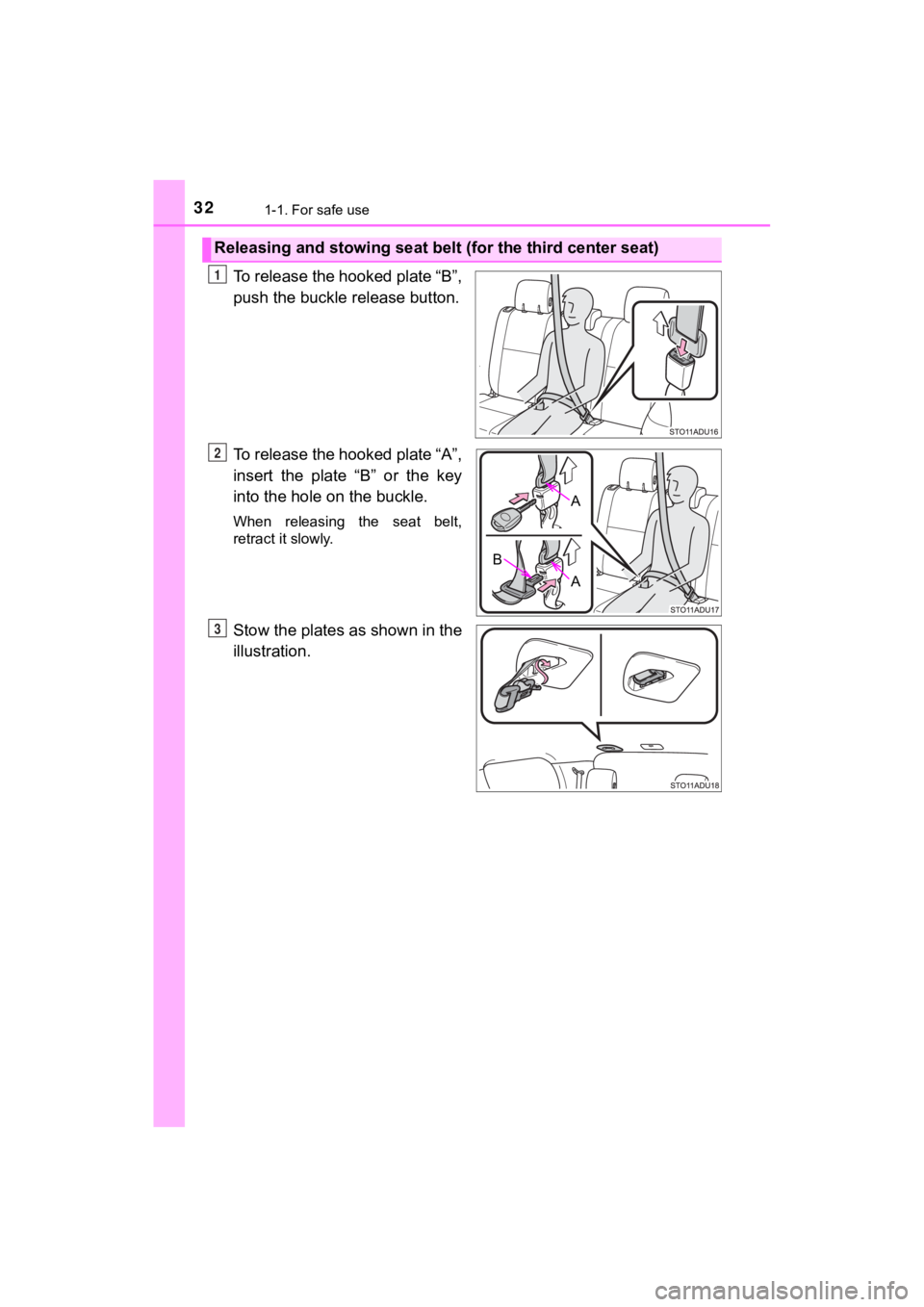
321-1. For safe use
SEQUOIA_OM_USA_OM0C021U_20MY
To release the hooked plate “B”,
push the buckle release button.
To release the hooked plate “A”,
insert the plate “B” or the key
into the hole on the buckle.
When releasing the seat belt,
retract it slowly.
Stow the plates as shown in the
illustration.
Releasing and stowing seat bel t (for the third center seat)
1
A
B
A
O
P
Page 42 of 588
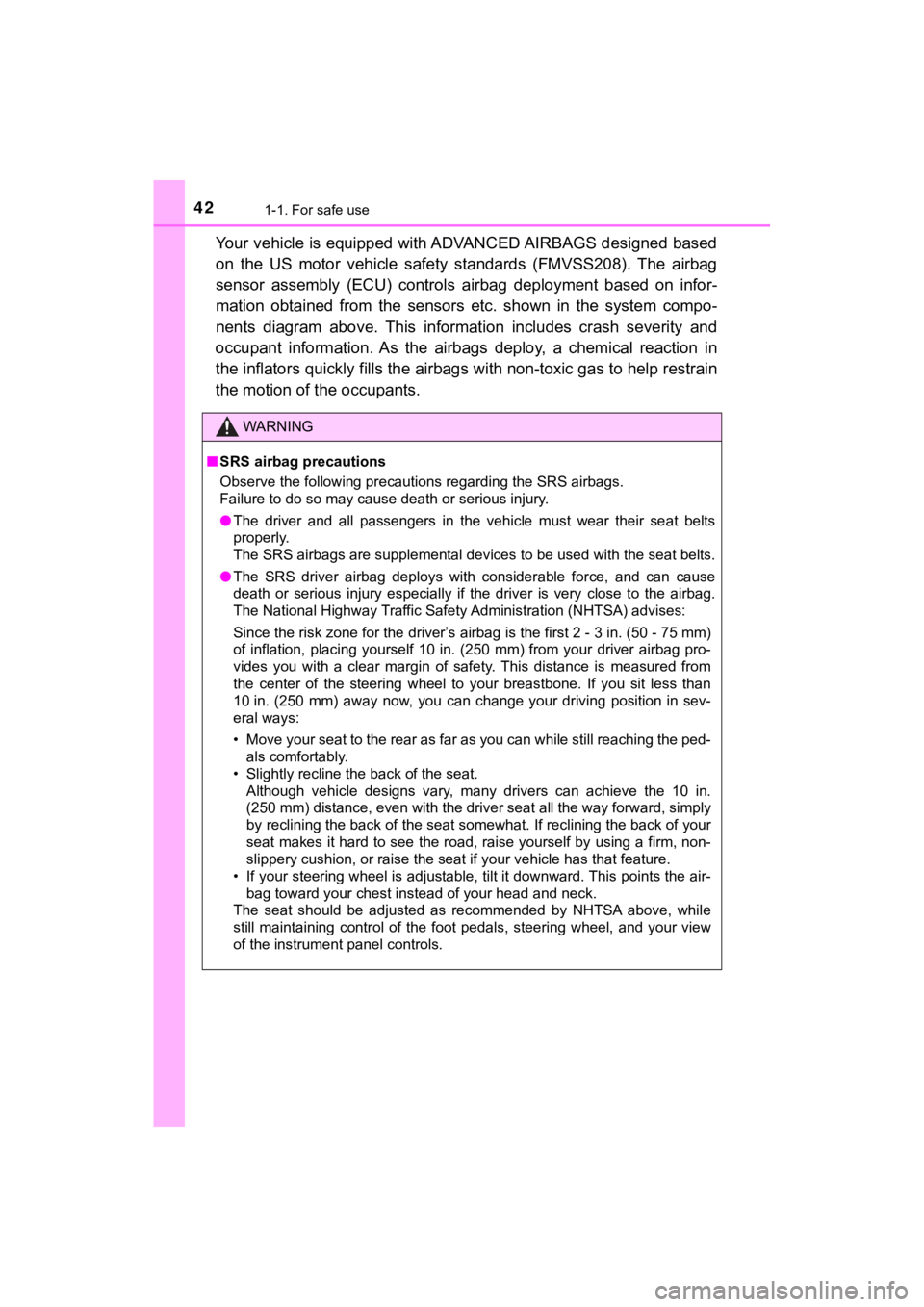
421-1. For safe use
SEQUOIA_OM_USA_OM0C021U_20MY
Your vehicle is equipped with ADVANCED AIRBAGS designed based
on the US motor vehicle safety standards (FMVSS208). The airbag
sensor assembly (ECU) controls airbag deployment based on infor-
mation obtained from the sensors etc. shown in the system compo -
nents diagram above. This informat ion includes crash severity and
occupant information. As the airbags deploy, a chemical reactio n in
the inflators quickly fills the airbags with non-toxic gas to h elp restrain
the motion of t he occupants.
WARNING
■SRS airbag precautions
Observe the following precautions regarding the SRS airbags.
Failure to do so may cause death or serious injury.
● The driver and all passengers in the vehicle must wear their se at belts
properly.
The SRS airbags are supplemental devices to be used with the se at belts.
● The SRS driver airbag deploys with considerable force, and can cause
death or serious injury especially if the driver is very close to the airbag.
The National Highway Traffic Safety Administration (NHTSA) advi ses:
Since the risk zone for the driver’s airbag is the first 2 - 3 in. (50 - 75 mm)
of inflation, placing yourself 10 in. (250 mm) from your driver airbag pro-
vides you with a clear margin of safety. This distance is measured from
the center of the steering wheel to your breastbone. If you sit less than
10 in. (250 mm) away now, you can change your driving position i n sev-
eral ways:
• Move your seat to the rear as far as you can while still reach ing the ped-
als comfortably.
• Slightly recline the back of the seat.
Although vehicle designs vary, many drivers can achieve the 10 in.
(250 mm) distance, even with the driver seat all the way forward , simply
by reclining the back of the seat somewhat. If reclining the ba ck of your
seat makes it hard to see the road, raise yourself by using a f irm, non-
slippery cushion, or raise the seat if your vehicle has that feature.
• If your steering wheel is adjustable, tilt it downward. This points the air-
bag toward your chest instead of your head and neck.
The seat should be adjusted as recommended by NHTSA above, whil e
still maintaining control of the foot pedals, steering wheel, and your view
of the instrument panel controls.
Page 44 of 588
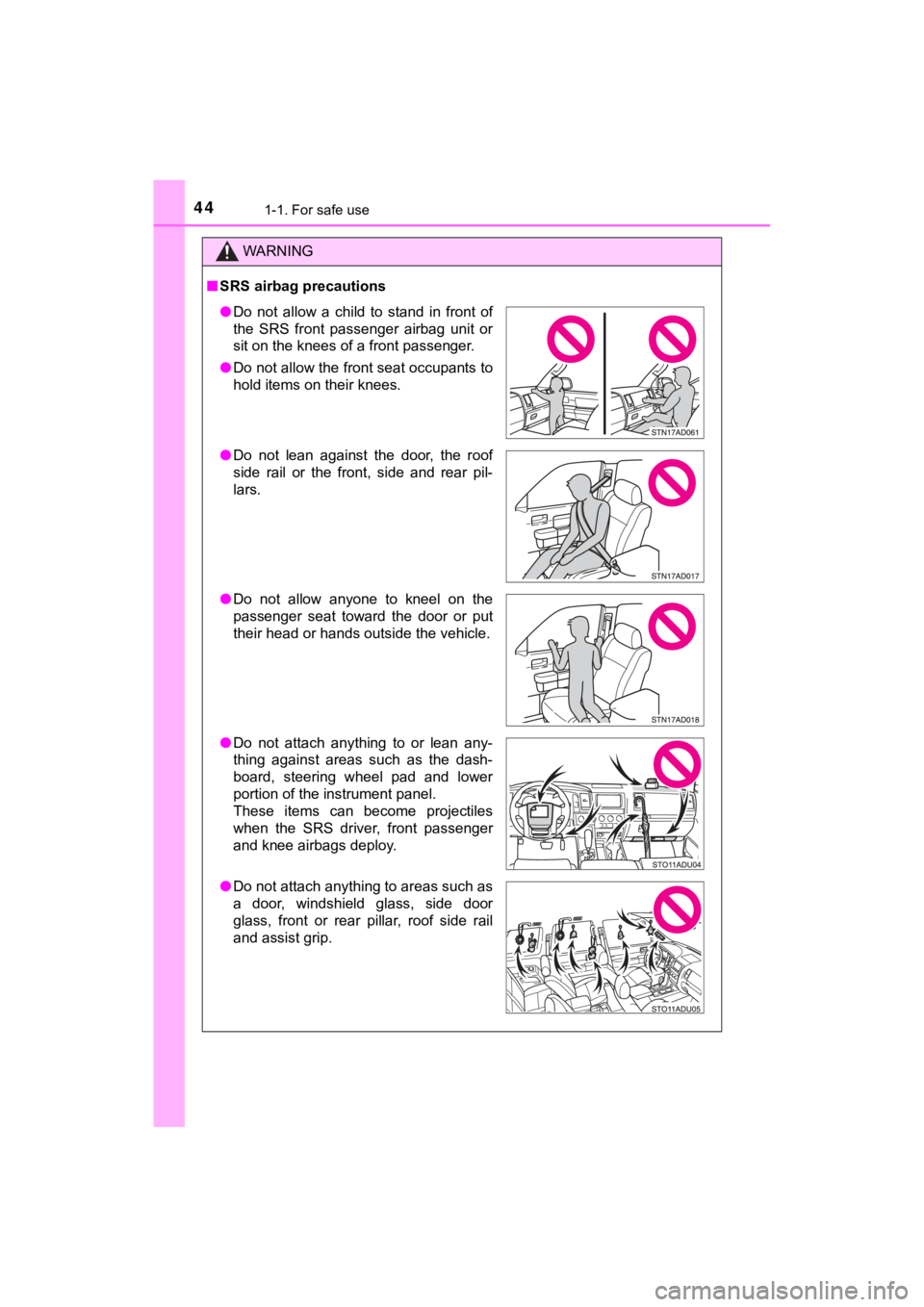
441-1. For safe use
SEQUOIA_OM_USA_OM0C021U_20MY
WARNING
■SRS airbag precautions
● Do not allow a child to stand in front of
the SRS front passenger airbag unit or
sit on the knees of a front passenger.
● Do not allow the front seat occupants to
hold items on their knees.
● Do not lean against the door, the roof
side rail or the front, side and rear pil-
lars.
● Do not allow anyone to kneel on the
passenger seat toward the door or put
their head or hands outside the vehicle.
● Do not attach anything to or lean any-
thing against areas such as the dash-
board, steering wheel pad and lower
portion of the instrument panel.
These items can become projectiles
when the SRS driver, front passenger
and knee airbags deploy.
● Do not attach anything to areas such as
a door, windshield glass, side door
glass, front or rear pillar, roof side rail
and assist grip.
Page 80 of 588
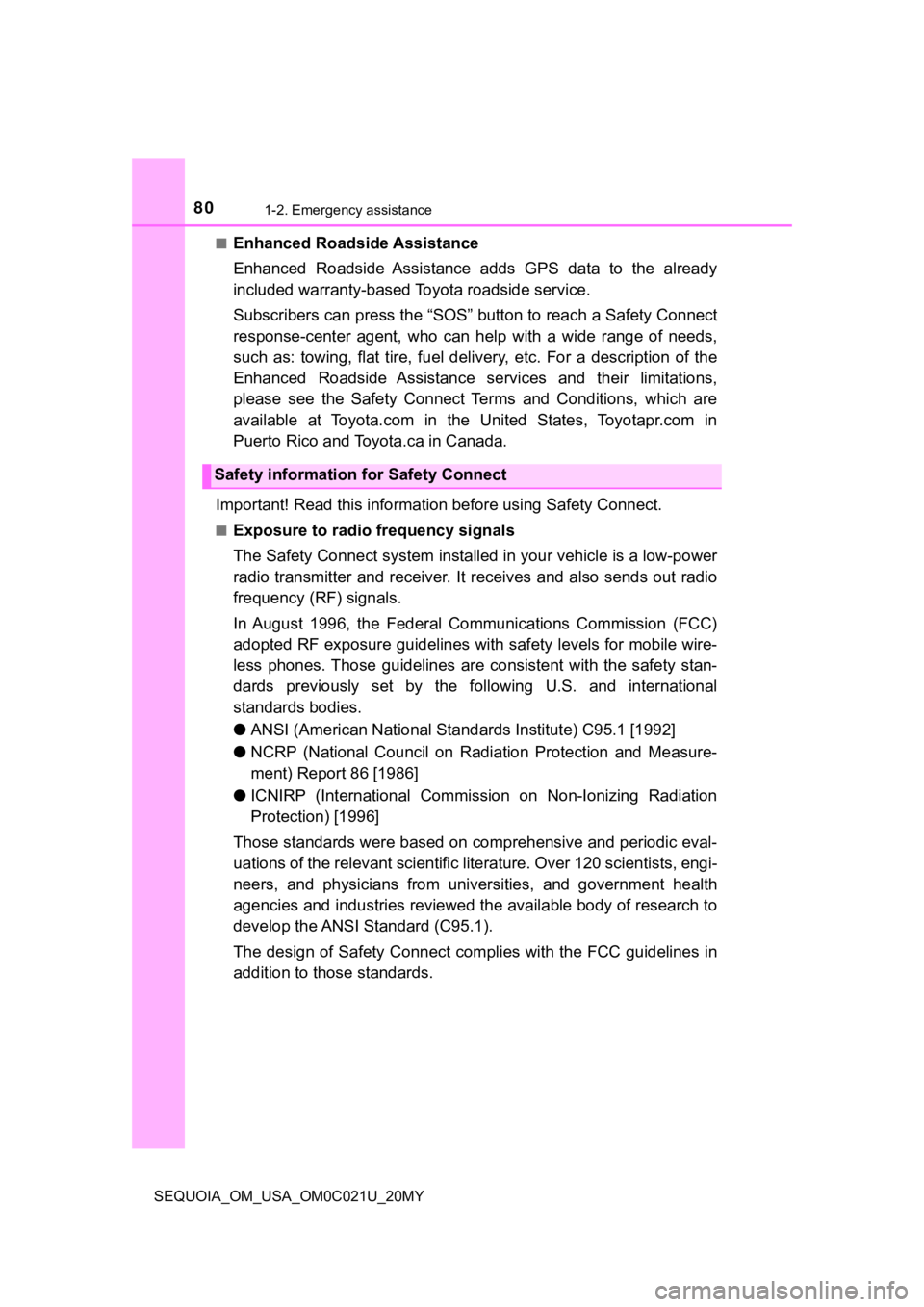
801-2. Emergency assistance
SEQUOIA_OM_USA_OM0C021U_20MY■
Enhanced Roadside Assistance
Enhanced Roadside As
sistance adds GPS data to the already
included warranty-based Toyota roadside service.
Subscribers can press the “SOS” button to reach a Safety Connec t
response-center agent, who can he lp with a wide range of needs,
such as: towing, flat tire, fuel delivery, etc. For a description of the
Enhanced Roadside Assistance se rvices and their limitations,
please see the Safety Connect Te rms and Conditions, which are
available at Toyota.com in the United States, Toyotapr.com in
Puerto Rico and Toyota.ca in Canada.
Important! Read this informatio n before using Safety Connect.
■Exposure to radio frequency signals
The Safety Connect system installed in your vehicle is a low-po wer
radio transmitter and receiver. I t receives and also sends out radio
frequency (RF) signals.
In August 1996, the Federal Communications Commission (FCC)
adopted RF exposure guidelines with safety levels for mobile wi re-
less phones. Those guidelines are consistent with the safety stan-
dards previously set by the following U.S. and international
standards bodies.
● ANSI (American National Stand ards Institute) C95.1 [1992]
● NCRP (National Council on Radi ation Protection and Measure-
ment) Report 86 [1986]
● ICNIRP (International Commission on Non-Ionizing Radiation
Protection) [1996]
Those standards were based on comprehensive and periodic eval-
uations of the relevant scienti fic literature. Over 120 scientists, engi-
neers, and physicians from unive rsities, and government health
agencies and industries reviewed the available body of research to
develop the ANSI Standard (C95.1).
The design of Safety Connect complies with the FCC guidelines i n
addition to those standards.
Safety information for Safety Connect
Page 92 of 588

922. Instrument cluster
SEQUOIA_OM_USA_OM0C021U_20MY
*1: These lights turn on when the engine switch is turned to ON to indicate thata system check is being performed. They will turn off after the engine is
started, or after a few seconds. There may be a malfunction in a system if
the lights do not come on, or do not turn off. Have the vehicle inspected by
your Toyota dealer.
*2: This light illuminates on the multi-information display.
*3: The light flashes to indicate that the system is operating.
*4: In order to confirm operation, the BSM outside rear view mirro r indicators
illuminate in the following situations:
• When the engine switch is turned to ON, the BSM function is en abled on
the screen of the multi-information display.
• When the BSM function is enabled on the screen of the multi-infor- mation display, the engine switch is turned to ON.
If the system is functioning correctly, the BSM outside rear vi ew mirror
indicators will turn off after a few seconds.
If the BSM outside rear view mirror indicators do not illuminat e or do not
turn off, there may be a malfunction in the system.
If this occurs, have the vehicle inspected by your Toyota deale r.
*5: This light illuminates on the center panel.
*6: This light turns on when the system is off.
(if equipped)
High speed four-wheel
drive indicator (P. 3 1 5 )
*1, 5
“AIR BAG ON/OFF” indi-
cators (P. 51)
(if equipped)
Low speed four-wheel
drive indicator ( P. 3 1 5 )
(if equipped)
“TOW/HAUL” indicator
(P. 222)
(if equipped)
Center differential lock
indicator ( P. 315)*2Low outside tempera-
ture indicator ( P. 94)
*1
(if equipped)
“AUTO LSD” indicator
(P. 320, 323)
Page 131 of 588

1313-2. Opening, closing and locking the doors
3
Operation of each component
SEQUOIA_OM_USA_OM0C021U_20MY■
Conditions affecting operation
The smart key system uses weak radio waves. In the following si tuations, the
communication between the electronic key and the vehicle may be affected,
preventing the smart key system, wireless remote control and en gine immobi-
lizer system from operating properly. (Ways of coping: P. 505)
● When the electronic key battery is depleted
● Near a TV tower, electric power plant, gas station, radio stati on, large dis-
play, airport or other facility that generates strong radio wav es or electrical
noise
● When carrying a portable radio, cellular phone, cordless phone or other
wireless communication device
● When the electronic key is in contact with, or is covered by the following
metallic objects
• Cards to which aluminum foil is attached
• Cigarette boxes that have aluminum foil inside
• Metallic wallets or bags
• Coins
• Hand warmers made of metal
• Media such as CDs and DVDs
● When multiple electronic keys are in the vicinity
● When other wireless keys (that emit radio waves) are being used nearby
● When carrying the electronic key together with the following devices that
emit radio waves
• Another vehicle’s electronic key or a wireless key that emits radio waves
• Personal computers or personal digital assistants (PDAs)
• Digital audio players
• Portable game systems
● If window tint with a metallic content or metallic objects are attached to the
back window
● When the electronic key is placed near a battery charger or ele ctronic
devices